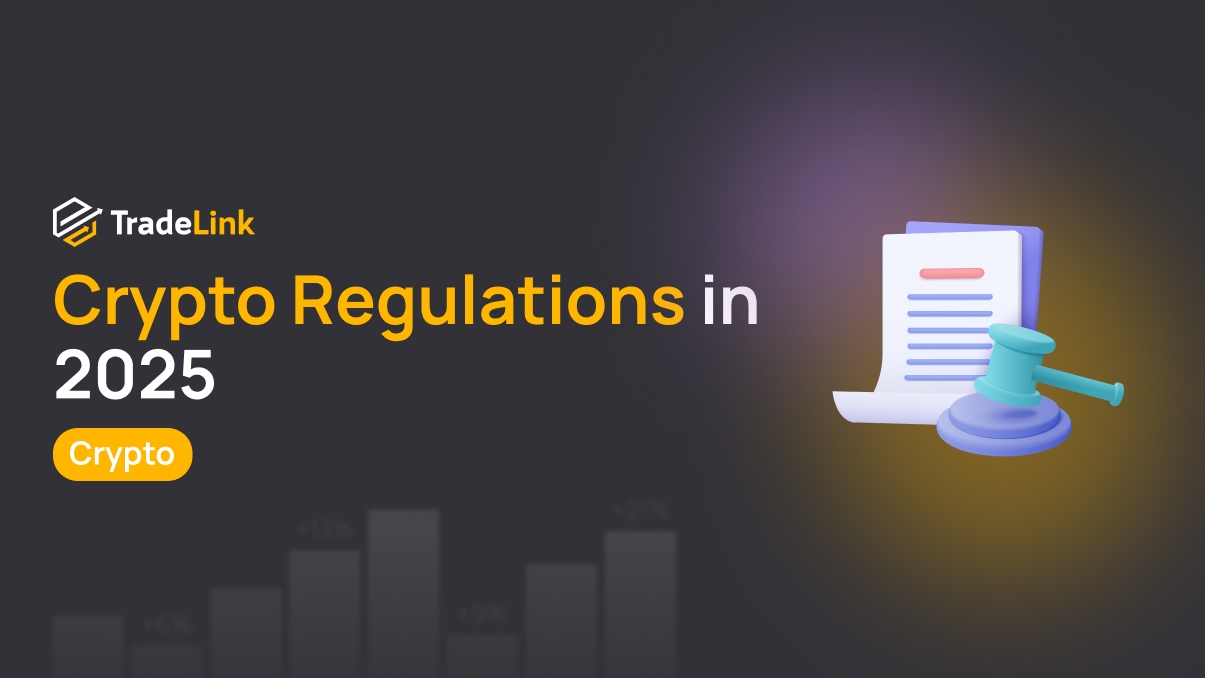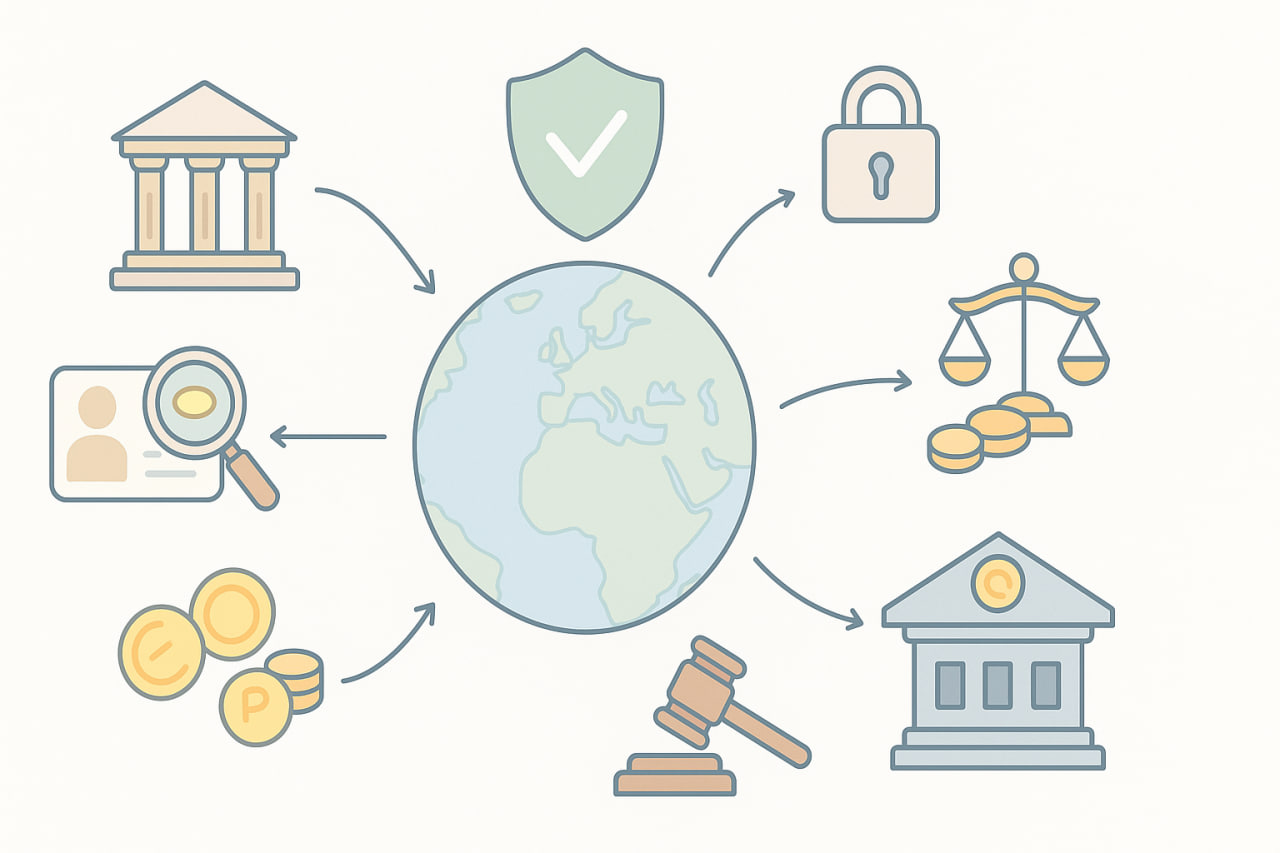Crypto Regulations in 2025: What Traders Need to Know Worldwide

Contents
- Introduction
- Current State of Cryptocurrency Regulation
- Cryptocurrency Regulation in 2025
- Impact of Regulation on Traders
- Opportunities and Risks for the Crypto Market
- How Traders Can Prepare for the New Rules
- Conclusion
Introduction
Interest in digital assets is growing. Against this backdrop, cryptocurrency regulation in 2025 is emerging as a key focus. Countries need clear rules to reduce risks and provide transparent conditions for the market. For a trader, this means access to exchanges, protection of funds, and understandable procedures.
Current State of Cryptocurrency Regulation

There is no unified approach in the world. Some countries take a strict line and shut down retail trading. Others allow exchanges to operate under license and oversee how participants store assets and advertise products. There is also a “middle path” with basic rules and clear client verification (KYC/AML). For a trader, it is essential to understand the legal status of cryptocurrencies in 2025 in their own country and to clarify cryptocurrency regulation by country on the chosen platforms.
Main Approaches to Regulation
-
Strict ban. Retail transactions are unavailable, and banks and payment services do not process operations.
-
Partial legalisation. Exchanges and custodial services operate under license, limits apply, participants disclose risks, and advertising is subject to control.
-
Framework system. The law outlines the roles of participants, establishes rules, and governs how companies store assets and protect clients, thereby constituting a framework for cryptocurrency regulation.
Any model affects commissions, the list of available tokens, and the legal risks of crypto trading.
Cryptocurrency Regulation in 2025
In 2025, precise requirements will appear for stablecoins, custodians, and risk disclosure. Exchanges need clear procedures and crypto-compliance 2025, while traders need clear coin statuses and public withdrawal limits with standardised fees. In practice, this provides less uncertainty and more predictable conditions.
United States
Regulators focus on client protection and on ensuring that licensed players store assets under established rules.
-
For traders, this means clearer procedures at services, standardised risk disclosures, and understandable withdrawal limits.
-
For exchanges, internal regulations, conflict of interest controls, and incident reporting are essential.
Bottom line: rules will become stricter and more precise in key jurisdictions, while access to basic products will remain if requirements are met.
Europe
The EU has a single framework for providers and tokens. The regulator sets standard admission criteria and pays attention to listing quality and client protection.
-
Traders see standardised conditions for withdrawals, reporting, and complaint handling.
-
Platforms align verification processes and publish rules for stablecoins.
The region maintains uniform standards, which simplifies work across multiple exchanges simultaneously.
Asia and Emerging Markets
Approaches vary. In some places, the market is closed to retail. In others, licensing and strict listing control apply. India is tightening taxation and transaction reporting. Japan emphasises client protection and stable platform operation. In emerging markets, rules change more frequently, so it is essential to track regulatory changes in the crypto market and local financial regulations for cryptocurrencies.
International Standards
Global organisations strive to align practices among countries. The goal is a standard set of requirements for client verification, reporting, and provider operations. International cryptocurrency rules do not replace laws but provide a common language for regulators and businesses. Exchanges publish standards for withdrawals and risk management, providers confirm the origin of client funds, and traders receive clear forms and processing timelines.
Impact of Regulation on Traders

Regulations affect access to exchanges, coin selection, and transaction costs. In 2025, cryptocurrency regulation is expected to become stricter and more transparent in key jurisdictions.
Retail traders will gain more protection but will undergo additional checks and provide more data. Institutional participants will see clear frameworks for custody, listing, and reporting.
At the global level, a unified approach is being shaped, reducing disputes and helping establish standard limits. For planning purposes, it is essential to understand the local cryptocurrency laws applicable to traders and the policies of the chosen exchanges.
KYC and AML Requirements
Exchanges are strengthening identity checks and verifying the origin of funds. This is part of Crypto Compliance 2025 and a direct continuation of the course toward security. For a trader, it is essential to complete verification once and keep the data up to date.
What is Usually Requested
-
Passport or another photo ID
-
Document confirming address
-
Brief description of the source of funds
-
Photo or video with the document according to the platform’s instructions
How to Reduce the Risk of Account Blocks
-
It is better to upload clear scans without cropped edges
-
It makes sense to keep identical data across all profiles and payment channels
-
It is advisable to keep receipts for deposits and withdrawals
-
It is helpful to check the account status after updates to the rules
What a Trader Gets
-
More predictable access to trading
-
Clear withdrawal limits and timelines
-
Fewer disputes in cases of errors and refunds
Taxes
Most countries consider profits from transactions as income. The difference between buying and selling is calculated, taking commissions into account. Income from staking and mining can also be subject to taxation. Here, a clear legal status of cryptocurrencies in 2025 in your jurisdiction is helpful.
Example: A trader buys a coin at one price and sells it at a higher price on the same exchange; the tax is calculated on the difference, including the exchange’s commission.
What Can Be Considered a Taxable Event
-
Selling a coin at a higher price than it was purchased
-
Exchanging one coin for another
-
Receiving rewards from staking or mining
-
Paying for goods and services with cryptocurrency
How to Simplify Accounting
-
Keep records of entry and exit prices.
-
Add commissions and conversion rates.
-
Separate operations by exchanges and wallets.
-
Save reports from platform dashboards.
-
Combine a trade journal with real-time portfolio statistics: this way, you reconcile records with objective metrics and prepare reports faster, with fewer discrepancies.
Restrictions on Instruments
In some countries, regulators restrain risks. Rules for crypto exchanges and the regulatory framework for cryptocurrency affect leverage, access to derivatives, and the status of anonymous coins.
Example: An exchange limits leverage for new clients and warns about liquidation risks before opening a position.
What Can Be Restricted
-
Maximum leverage for futures
-
List of coins with private transactions
-
Advertising of high-risk products
-
Listing of tokens without transparent information
-
Issuance and circulation of certain stablecoins
How This Affects Trading
-
Liquidations happen less often during high volatility
-
Fewer disputes with customer support
-
Projects disclose more data for listing and update documents more frequently.
Opportunities and Risks for the Crypto Market

Clear rules increase trust in platforms and improve liquidity. Banks and funds enter the market, and global cryptocurrency regulation intensifies. But there is also a downside: anonymity decreases, some projects move into uncertain regulatory zones, and compliance costs rise. Below is a short guide for individual participants.
Change | Plus for the Market | Risk or Minus | What the Trader Does |
Transparent listing rules | Increased trust in new tokens | Access to some assets may narrow | Checks project information and sources of liquidity |
Stricter KYC and AML | Fewer fraudulent schemes | More time is required for verification | Prepares documents in advance and keeps transfer confirmations |
Stablecoin requirements | Lower issuer-related risks | Possible restrictions on certain coins | Keeps a reserve in permitted stablecoins and tracks reports |
Limits on leverage and derivatives | Fewer sharp liquidations | Reduced potential for aggressive strategies | Adjusts position size and uses partial profit-taking |
Clear tax rules | Predictable reporting | Higher accounting burden | Keeps a transaction log and saves reports from exchanges |
How Traders Can Prepare for the New Rules
What do traders need to know about cryptocurrency regulation in 2025? Below is a short plan to help avoid problems.
Steps for the Coming Month
-
It makes sense to check account statuses on exchanges and complete any missing verification levels.
-
It is better to update the trade journal and reconcile commissions across all wallets and platforms.
-
It is advisable to clarify leverage limits and derivative availability in your jurisdiction.
-
It is helpful to review the list of available stablecoins and withdrawal rules.
-
It makes sense to set reminders about updates from regulators and exchanges.
Mini Checklist Before a Trade
-
Make sure the instrument is legal in your country
-
Check the coin’s status on the exchange and the risk of delisting
-
Take into account commissions, taxes, and conversion rates
-
Plan an exit strategy and acceptable loss in advance
Sound Practices for the Whole Year
-
Once a quarter, it is helpful to reconcile your portfolio with the platform report.s
-
It is better to store copies of documents and statements in a secure cloud
-
It makes sense to keep a small reserve of funds visible for commissions and taxes
Conclusion
Cryptocurrency regulation in 2025 is expected to become stricter and more precise in key jurisdictions. Clear frameworks attract institutional capital and systematise listings, while in return requiring more careful accounting and verification.
The success of a trader rests on three pillars: understanding local rules, keeping accurate records of operations, and choosing platforms with published withdrawal limits and standardised fees. This approach helps navigate changes with less uncertainty and provides a clear view of how global rules affect crypto trading.